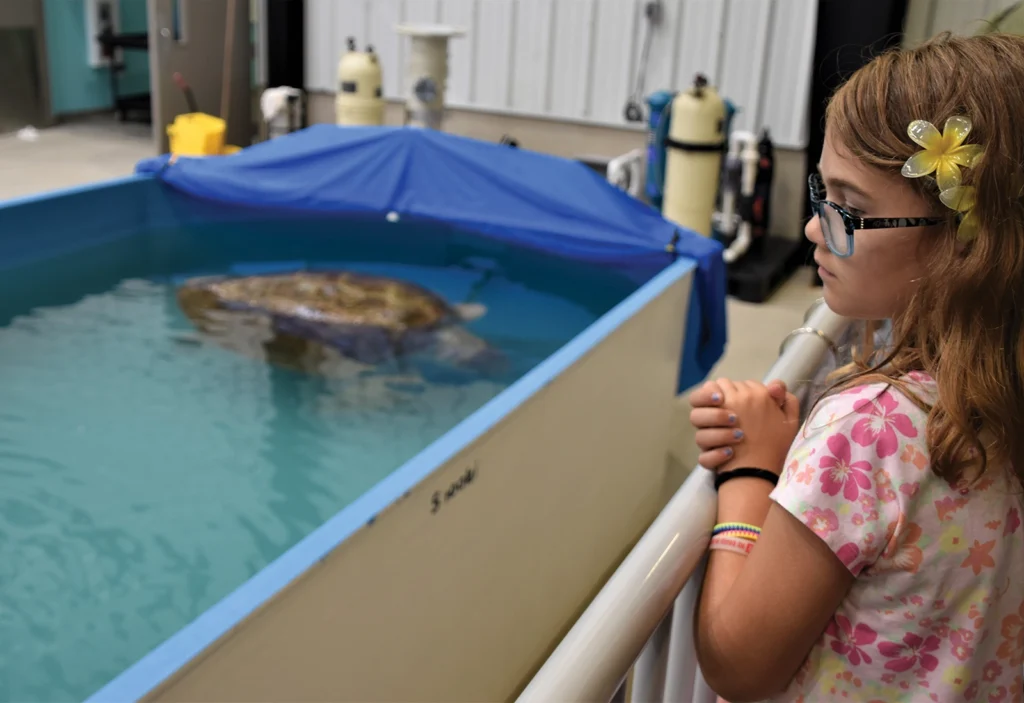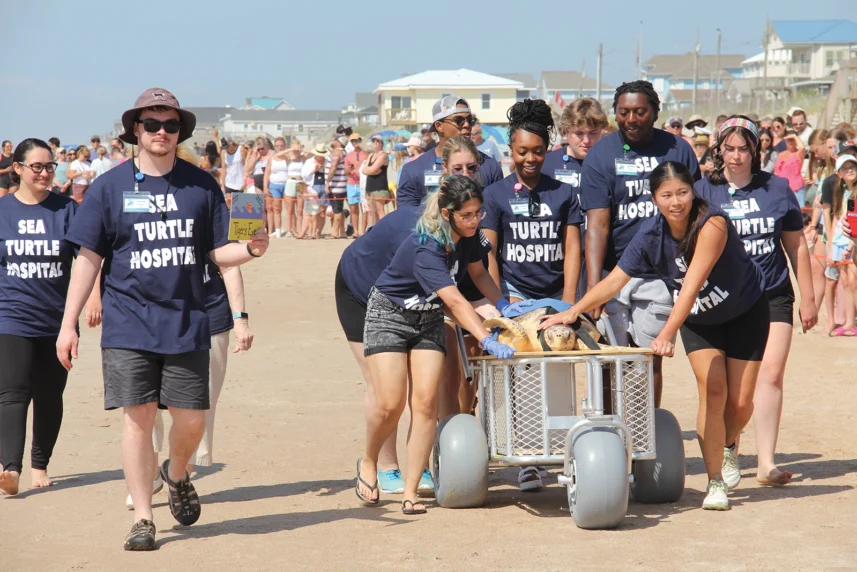BY MARILYN JONES
Men, women and children are sitting around a porch waiting for the tour to begin when I arrive at the Karen Beasley Sea Turtle Rescue and Rehabilitation Center in Surf City on Topsail Island.The doors open shortly after I check in with the tour leader, and we follow volunteer Cindy Kay past the massive Ocean of Memories wall mural and into the world of sea turtles.
At the first station of the tour, we watch a film as Cindy narrates what we are viewing. We learn that from May 1 through August 31, volunteers walk the 26 miles of Topsail Beach looking for turtle nests. In addition to monitoring the nests, volunteers care for injured and sick turtles at the facility with the ultimate goal of returning them to the ocean.
Jean Beasley, the center’s founder, bought a home in Surf City with her husband in 1970. On the first night they lived there a sea turtle laid its eggs on the beach in front of her home, and the turtle and its eggs fascinated Beasely’s daughter Karen.
Jean and Karen Beasley eventually created the Topsail Turtle Project, the first program established in North Carolina to preserve sea turtles. The program’s volunteers cared for the injured sea turtles while monitoring the beach for nests each morning and ensuring that baby sea turtles made the dangerous journey from their nests safely to the water each night.

In 1991, after a long battle with leukemia, Karen passed away. Jean Beasley committed herself to carrying on her daughter’s legacy through sea turtle conservation.“Karen told me before she died that if she didn’t make it, she wanted me to use her life insurance money to help sea turtles,” says Beasley.
In 1997, Beasley used the money Karen left to create the Karen Beasley Sea Turtle Rescue and Rehabilitation Center. The original center was a 900-square-foot space located in the town of Topsail Beach. In just a decade, the facility became too small for the scale of work the rehabilitation center was doing, so in 2013 a new, 14,000-square-foot facility was opened in Surf City.
In addition to caring for sea turtles, the Surf City space allows for tours and other means by which the center can educate the public. “Guests visiting the Karen Beasley Sea Turtle Rescue and Rehabilitation Center get a first-hand view of a working sea turtle hospital. All proceeds from ticket sales, gift shop sales and symbolic adoptions go toward our sea turtle conservation, rehabilitation and education programs,” says Kathy Zagzebski, the center’s executive director. The building of the Surf City facility was made possible by fundraising, donations, and support from local businesses.
At each point along the center’s educational trail, visitors learn about the turtles living and nesting along Topsail Island—including loggerhead turtles; green turtles and Kemp’s ridley turtles, both of which are endangered; and leatherback turtles and hawksbill turtles (another critically endangered species), which are occasional residents of the region.

Further along the tour, visitors enter a large room where the facility cares for injured turtles in a series of saltwater pools. The center “combines state-of-the-art facilities, expert medical care and dedicated turtle care teams that help sick and injured sea turtles recover so they may be released back into the ocean,” says Zagzebski. She adds, “We treat various illnesses and injuries, including cold-stunning, hypothermia, debilitated turtle syndrome, entanglement, plastic ingestion, plastic entanglement, fish hook injuries, boat strikes, and shark and predator bites. In our 25-year history we have cared for over 1,300 sea turtles.”
The tour discusses each turtle and its medical situation. The facility’s patients most often sustain injuries from boat propellers, debris from the shoreline, predator attacks, changing water temperatures and guild nets from commercial fishermen.
When they can, volunteers return sea turtles to the wild. If life in the ocean is no longer possible for the turtle, the facility finds it a suitable home in an accredited zoo or aquarium.The facility depends on the help of veterinarians from North Carolina State University’s Veterinary Hospital. Veterinarians and volunteers ensure that each turtle receives personal physical therapy, medicine, and specially formulated diets administered through hands-free feeding in order to make certain that turtles will not depend on humans upon release.
Visitors also learn about the perils facing the turtles, including litter and plastics. We learn that the marine ecosystem depends upon the health of its sea turtles. Turtles maintain seagrass beds and coral reefs, control jellyfish and sponge populations, and transport nutrients to other parts of the ocean and the beach. By helping sea turtles, we can help keep oceans healthy for the benefit of animals and people.

The center emphasizes that individual actions do make a difference. “Whether or not you live near the coast, there is a lot you can do to help sea turtles,” says Zagzebski. “Replace single-use plastic with more sustainable alternatives, recycle everything possible and dispose of trash responsibly.
“Remember—all drains lead to the ocean.” She adds, “Use your voice and advocate for sea turtles and healthy oceans! Vote for candidates that support these goals. Vote with your wallet and choose to purchase sustainable products. And support sea turtle conservation organizations.”
Visiting the Karen Beasley Sea Turtle Rescue and Rehabilitation Center
The center is located at 302 Tortuga Lane in Surf City, about 45 minutes north of Wilmington. Admission is $5 for children, $6 for military and seniors and $7 for everyone else. The timed tours last about 45 minutes. For more information, visit seaturtlehospital.org.


